Introduction: Understanding the Need for Reapportionment
Reapportionment stands as a pivotal process in democratic governance, ensuring that the distribution of political power accurately reflects the evolving demographics of a population. Without regular reapportionment, disparities can arise, leading to unequal representation and a potential erosion of public trust. The following article will delve into the concept of reapportionment, exploring its significance and showcasing real-world examples that illustrate its impact.

What is Reapportionment?
Reapportionment refers to the periodic redrawing of electoral boundaries, primarily based on population shifts as revealed by the latest census data. Its purpose is to ensure that each electoral district contains roughly the same number of people, thereby guaranteeing that each vote holds approximately equal weight. By keeping representation in line with population changes, reapportionment safeguards the principle of “one person, one vote.”
Significance of Reapportionment
Reapportionment plays a crucial role in maintaining a fair and equitable democracy. When electoral boundaries remain unaltered for extended periods, population shifts can cause significant disparities in representation. Areas with dwindling populations may continue to elect the same number of officials, while rapidly growing areas may be underrepresented.
Such imbalances can lead to:
- Unequal representation: Certain regions may wield disproportionate influence compared to others, undermining the principle of equal voting power.
- Erosion of public trust: Citizens may lose faith in the democratic process if they perceive their votes to be less impactful than those of others.
- Stunted policymaking: Governments may struggle to address the needs of all constituents when their representation does not accurately reflect the population’s composition.
Historical Examples of Reapportionment
Throughout history, reapportionment has been a contentious but necessary process. Here are a few notable examples:
- United States: The United States Constitution mandates a census every ten years, followed by the reapportionment of seats in the House of Representatives based on the population distribution.
- India: India has undergone several rounds of reapportionment since its independence in 1947, including the creation of new states and the redrawing of electoral boundaries to accommodate population growth.
- United Kingdom: The United Kingdom has implemented reapportionment mechanisms to address population shifts within its constituent nations and regions.
Contemporary Cases of Reapportionment
Reapportionment continues to be a relevant issue in modern democracies. Recent examples include:
- California, USA: In 2020, California’s reapportionment process resulted in a slight decrease in the number of its congressional districts, reflecting population growth in other states.
- Canada: Canada’s electoral boundaries are reviewed and adjusted after each census, ensuring that the distribution of seats in the House of Commons reflects population changes.
- Australia: Australia’s independent Electoral Commission conducts reapportionment based on population data, drawing new boundaries for electoral divisions every year.
Benefits of Reapportionment
Regular reapportionment offers several advantages, including:
- Fair representation: Ensures that each citizen’s vote carries roughly equal weight, regardless of geographic location or population density.
- Enhanced public trust: Promotes confidence in the democratic process by ensuring that the electoral system is just and equitable.
- Improved policymaking: Allows governments to better respond to the needs and preferences of their constituents, as their representation accurately reflects the population’s composition.
Challenges and Controversies
Reapportionment is not without its challenges and controversies:
- Gerrymandering: Political parties may attempt to manipulate electoral boundaries to gain an unfair advantage in elections, a practice known as gerrymandering.
- Delay in implementation: The reapportionment process can be delayed or obstructed by political maneuvering, resulting in outdated electoral boundaries that fail to reflect current population distributions.
- Legal battles: Disagreements over reapportionment plans can lead to legal challenges, sometimes resulting in lengthy court battles and further delays in implementation.
The Future of Reapportionment
As populations continue to grow and shift, reapportionment will remain an essential mechanism for maintaining fair and equitable representation in democratic societies. Advancements in technology and data analysis may lead to more accurate and efficient reapportionment processes in the future.
Conclusion
Reapportionment serves as a cornerstone of democratic governance, ensuring that the distribution of political power reflects the evolving demographics of a population. By safeguarding the principle of “one person, one vote,” reapportionment promotes fair representation, enhances public trust, and fosters more responsive policymaking. While challenges and controversies may arise, the benefits of regular reapportionment far outweigh its complexities, making it a vital process for upholding the integrity of democratic systems.
Additional Information
Tables:
| State | Population Change (2010-2020) | Number of Congressional Districts (2020) |
|---|---|---|
| California | -153,399 | 52 |
| Texas | +4,265,099 | 38 |
| Florida | +2,716,142 | 28 |
| New York | -843,843 | 26 |
| Pennsylvania | -46,905 | 17 |
Glossary:
- Electoral district: A defined geographic area that elects a single representative to a legislative body.
- Reapportionment: The periodic redrawing of electoral boundaries based on population changes.
- Gerrymandering: The manipulation of electoral boundaries to favor a particular political party or candidate.
Key Figures:
- The United States Constitution mandates a census every ten years, followed by the reapportionment of seats in the House of Representatives.
- India has undergone several rounds of reapportionment since its independence in 1947, including the creation of new states and the redrawing of electoral boundaries to accommodate population growth.
- Canada’s electoral boundaries are reviewed and adjusted after each census, ensuring that the distribution of seats in the House of Commons reflects population changes.
Questions for Discussion:
- Why is reapportionment necessary in a democracy?
- What are the potential consequences of delaying or obstructing reapportionment?
- How can technology be leveraged to improve the accuracy and efficiency of reapportionment processes?
